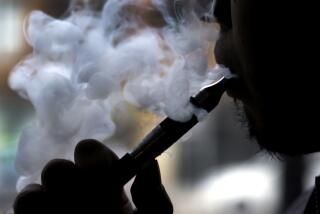Tobacco Firms Targeted Blacks, Documents Show
- Share via
WASHINGTON — Damaging information about the tobacco industry was disclosed here Thursday as a congressman released documents detailing the industry’s attempts to specifically target African Americans, in particular African American youths.
Rep. John Conyers Jr. (D-Mich.), who released the material, said: “These documents make clear that the tobacco industry was targeting blacks, including black teenagers, at the same time the industry knew that tobacco was addictive and caused lung cancer and other smoking-related disease.”
For example, a 1973 R.J. Reynolds Tobacco Co. marketing profile included a study of black smokers ages 14 to 20.
A 1973 Brown & Williamson Tobacco Corp. document on blacks said that the bulk of sales increases in the company’s Kool brand was among 16- to 25-year-olds. “At the present rate, smokers in the 16- to 25-year age group will soon be three times as important to Kool as a prospect in any other broad age category.”
A 1978 Lorillard Tobacco Co. research study noted that the success of its Newport brand had been “fantastic during the past few years.” While the study said the brand was being purchased by black people of all ages, it emphasized that “the base of our business is the high school student.”
Thursday’s disclosures come on the heels of the release of a cache of RJR marketing documents in mid-January that provided the broadest picture to date of industry targeting of teenagers. And in the last two weeks, attorneys representing Minnesota in its massive case against the industry have introduced in court several dozen internal industry documents providing new details about how the industry knew years ago about both the health hazards and addictiveness of its products.
Attorneys in Minnesota are also anxiously awaiting a judicial ruling on whether they can obtain 240,000 more documents that the industry is trying to keep secret, on top of the 33 million pages of company documents that the state has gathered. Much of it is still under seal but is expected to emerge during the trial.
Conyers noted that lung cancer accounts for 25% of all cancer cases in African American males, compared to 14% of all cancer cases in the general population. Moreover, he said that from 1950 to 1985, the occurrence of lung cancer increased 220% among black men, compared to 86% among white men. “Now, we know that part of the blame lays squarely at the feet of the tobacco industry.”
The veteran congressman released the documents as the House Judiciary Committee held a hearing on the proposed $368.5-billion national tobacco settlement.
“Unfortunately, eight months after the settlement was announced, we still don’t have a complete picture of the extent to which these marketing tactics were executed and the degree they were utilized by other members of the tobacco industry,” Conyers said. “That is why I am today calling for the complete release of all incriminating industry documents. Until this information is disclosed, Congress cannot intelligently determine whether the proposed civil liability relief [the industry seeks] is appropriate or ascertain the necessary amount of funds and smoking relief programs which needed to be provided in the black community to counteract the pervasive marketing of cigarettes they have faced.”
At the hearing, the Clinton administration, tipping its hand for the first time on a key aspect of the mammoth settlement now under consideration in Congress, said it could accept special legal protections for tobacco companies.
David Ogden, a counselor to Atty. Gen. Janet Reno, told the committee that limits on liability for the companies may be the price of securing the tobacco industry’s agreement to scale back its marketing and advertising and finance anti-smoking programs.
“If there is agreement on a comprehensive bill . . . then reasonable provisions modifying the civil liability of the tobacco industry would not be a deal-breaker,” Ogden said.
Ogden made clear, however, that the legal protections for the industry must be narrowed considerably from those that were part of the settlement reached last year between the tobacco companies and the 40 states that had sued them. He repeatedly emphasized that restricting liability is not the administration’s preference, and at the end of the day, many lawmakers and experts were still confused about exactly what the administration will accept.
Special legal protection for the tobacco industry is the linchpin of the proposed settlement. The industry agreed to drastically limit marketing and advertising aimed at children, accept regulation by the Food and Drug Administration, finance programs aimed at deterring young people from smoking and partially reimburse the states for their tobacco-related health costs in exchange for limits on their liability in damage suits.
The settlement depends on Congress to give the companies their legal protections and limited immunity from antitrust laws so that they can agree on prices for their products. But many lawmakers are reluctant to grant such preferences to an industry that is under criminal investigation by the Justice Department.
The legal protections sought by the tobacco companies and included in the settlement are:
* No future class-action or multi-case lawsuits against the companies.
* A cap starting at $2 billion and rising to $5 billion on the annual payments by the industry in judgments and settlements of lawsuits brought by individuals.
* No more lawsuits by states against the companies.
* No punitive damage awards against the companies for past conduct.
In commenting on the settlement, Ogden suggested that Congress consider combining limitations on the tobacco companies’ liability with provisions to make it easier for plaintiffs to recover damages from the industry. To date, individual smokers have won only one claim against the industry for tobacco’s health effects. Justice Department lawyers appeared to have in mind something along the lines of the workers’ compensation system.
“There have been compensation-type schemes developed under which procedures have been simplified . . . that would be one option,” said Ogden.
Ogden emphasized that Congress needs to give the industry incentives to turn over all its documents. Secret documents have proved to be the most powerful weapon for plaintiffs and lawyers against the industry.
He proposed that punitive damages “be retained with respect to claims based on facts not disclosed by the tobacco manufacturers to Congress and the public.”
The administration’s willingness even to entertain limitations on the companies’ liability opened the door to the possibility that Clinton would give members of Congress the political cover many are seeking on the highly charged issue. Some committee members heralded Ogden’s testimony as a major development, while others derided the administration for refusing to lay out the specifics of its position.
When Ogden started to explain his position, Rep. Barney Frank (D-Mass.) cut him off. “Spare me that . . . I resent the administration’s unwillingness to get specific,” he said.
Similarly critical were anti-smoking advocates who believe it is a mistake to give away the legal remedies that have helped bring the industry to the bargaining table. Today’s testimony “surely weakens the administration’s negotiating position on what are ‘reasonable’ limitations on civil liability law,” said Alan Morrison, the director of Public Citizen’s litigation unit.
The documents Conyers released were obtained during recent litigation, including a San Francisco case in which attorneys had sued RJR over its controversial Joe Camel campaign.
In addition to the ones involving African Americans, there were several dealing with general teen marketing. These included a 1972 B&W; memo about attempts to lure young smokers with sweet cigarettes, including the use of artificial ingredients to generate a cola taste. “It’s a well-known fact that teenagers like sweet products. Honey might be considered,” noted the memo, which was marked “confidential.”
Weinstein reported from Los Angeles and Rubin from Washington.
More to Read
Inside the business of entertainment
The Wide Shot brings you news, analysis and insights on everything from streaming wars to production — and what it all means for the future.
You may occasionally receive promotional content from the Los Angeles Times.









